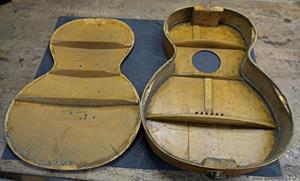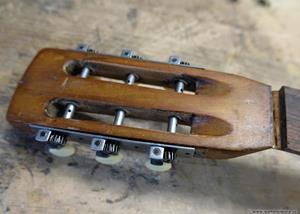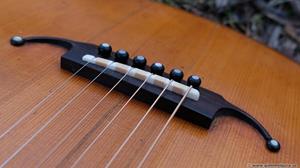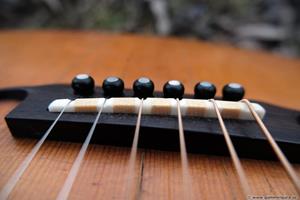The most odd parlor guitar in the ongoing batch is ready, a European guitar from the waiting room and around 1915. The unusual thing about it is to begin with the neck which is not in maple but most likely in Spanish cedar. The neck is both narrow and thin, almost like an electric guitar neck. Mens watch unusually short, 60 cm. The bottom had an extreme radius and the original ribs inside were of monster size, the biggest and fattest ribs I have seen! As a spice to the mash, the end plug had been replaced with an overgrown "thimble" glued and filled with something similar to plastic padding.
I suspect this guitar was later rebuilt by someone with their own and not so good ideas. The neck in Spanish cedar, on the other hand, is original. The bottom is probably replaced and definitely the ribs 🙂
This was meant for a customer, but as the neck was unusually narrow and the customer mostly playing finger games, we agreed to start over on another guitar with a wider grip board. The narrow neck, on the other hand, makes it very easy to play with plectrum. Now it depends on sales at Östmans Musik in Örnsköldsvik for those who want to test it. If anyone reading this is looking to buy a finished GG for Christmas, just contact me.
Here are some pictures of surprise I got when I opened the guitar. The lid was coated with skin glue and the ribs huge. There were also small reinforcements of the notch to the bottom.
The tuning screws were not in the best condition, so the old holes were plugged and new holes were drilled for Golden Age tuning screws with a modern distance between the posts. Using tape to mark the center of the center post, the holes are drilled with Stewmac's fine (and expensive) notched jig. Once the guitar has been varnished, the holes are drilled out a little extra (7.1 mm drill) and 12 simple metal bushings are glued in with fish glue. A little premium, but practical as the string can not get caught between the post and the wood and the post does not wear on the wood. The string also responds a little better when the string is fastened with a hard surface to the post. Will be a little higher volume and better attack.
The neck got a carbon fiber rod and cap and bottom new ribs. The neck foot had cracked and glued together as well, glued an 8 mm birch stick through the neck foot across the crack with epoxy glue. Some cracks in the lid were filled with spruces. New for this batch is a thin fir plate between the two lower ribs below the sound hole. My experience is that thin fir glued with skin glue does not affect the sound negatively if it is glued with the vein in the same direction as the lid, rather the opposite. I wanted to strengthen the middle of the lid to hold better for the string, otherwise there may be a tendency to pit in the lid between the two ribs. The plate is thin, about 1,5 mm in the middle and thinned to nothing at the edges on either side. You never want a thick border along with a fiber in the lid, where it can easily form a crack. In the picture, reinforcements in hardwood are glued around the string holes in the fir plate in spruce.
A K&K was mounted before the bottom was glued back. Note the "pendant" on the longest bottom rib. The first time I made such a bar with double curves 🙂
Tried to reuse the original board but when everything was in place I realized that the men's watch for the straps did not match the position of the stall. Had to redo both neck turn and grip board with a slightly shorter mens watch than the original, 59,8 mm instead of 60 cm. There, some working days disappeared unnecessarily. To my surprise, the skin glue did not attach properly to the neck, reminded me that the original board was also easy to loosen. Apparently, the wood in the neck is difficult to glue. Used the slightly stickier fish glue for the new board in Madagascar rosewood and it seems to sit well. A crack in my head had also been glued with warm skin glue, even it cracked up when I pulled a screw to the tuning screws. Used super glue in the crack which did what it should.
Made a new mustache stall in Madagascar rosewood and oversead toned in the usual order. A pair of cut off tops on old string sticks supplemented the mustache tips. Starting to get cut on making segmented stall legs now, looks better than ever!
Used two birch plugs for the E and A strings and endwood of spruce for the G, b and e strings. To get a little more even volume I used a plug in the endwood of pine for the D string, pine is harder than spruce but not as hard as birch. So I will do in the future to get a more even volume distribution between the strings.
Am happy with how it turned out. It feels stable and sounds and tones well. The bottom is very stiff and does not sound with but only acts as a sounding board for the sound from the lid. The bottom is in plywood, another sign that it has been replaced. Maybe the projection increases and the volume is directed more forward with the curved bottom compared to a "regular" bead with a softer and flatter bottom. The difference in sound is probably quite marginal, but maybe the difference is heard for someone who stands in front and listens and does not play.
Hangs as said at Östman's Music in Örnsköldsvik until it is sold. The lid had an unusually deep orange color and the neck in Spanish cedar was clear lacquered without color in the lacquer, what you see is the color of the wood itself. The short menstrual cycle, the narrow fretboard and the slender neck make it easy to play - at least with plectrum.























Hello!
Do you have a Levin parlor guitar in wood, not varnished.
Still available GG148, European circa 1915 for sale.
If you no longer have this model.
Do I have ways for you to have several European guitars.
GG171, European circa 1920
All GG are sold and with their buyers. However, I have one that needs a new owner, number 28. Either as it is in good condition and with oversaddle intonation, or completed with my latest inventions for an extra sum. An ad is coming. "The Rose"
karl.lagerberg@outlook.com